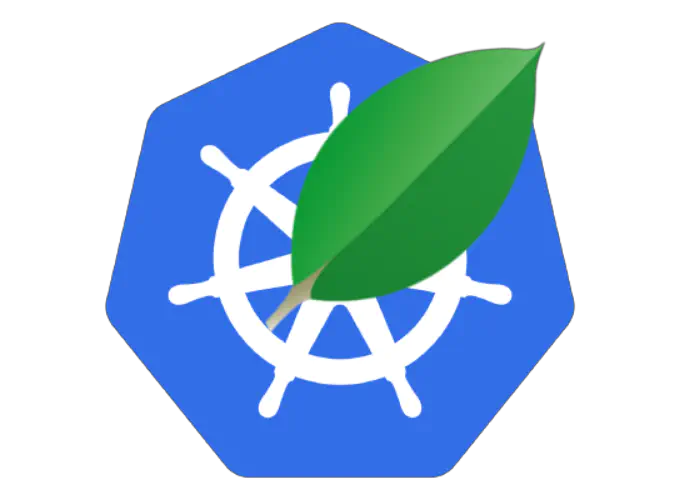Mongodb Replica Set on Kubernetes

Replica-Sets
Run MongoDB Replica Set on Kubernetes using Statefulset and PersistentVolumeClaim. Minikube kubernetes cluster is used for this post.
Create Secret for Key file
MongoDB will use this key to communicate internal cluster.
$ openssl rand -base64 741 > ./replica-sets/key.txt
$ kubectl create secret generic shared-bootstrap-data --from-file=internal-auth-mongodb-keyfile=./replica-sets/key.txt
secret "shared-bootstrap-data" created
Deploy MongoDB Replica-Sets YAML
apiVersion: v1
kind: Service
metadata:
name: mongodb-service
labels:
name: mongo
spec:
ports:
- port: 27017
targetPort: 27017
clusterIP: None
selector:
role: mongo
---
apiVersion: apps/v1
kind: StatefulSet
metadata:
name: mongod
spec:
serviceName: mongodb-service
replicas: 3
selector:
matchLabels:
role: mongo
environment: test
replicaset: MainRepSet
template:
metadata:
labels:
role: mongo
environment: test
replicaset: MainRepSet
spec:
containers:
- name: mongod-container
image: mongo:3.4
command:
- "numactl"
- "--interleave=all"
- "mongod"
- "--bind_ip"
- "0.0.0.0"
- "--replSet"
- "MainRepSet"
- "--auth"
- "--clusterAuthMode"
- "keyFile"
- "--keyFile"
- "/etc/secrets-volume/internal-auth-mongodb-keyfile"
- "--setParameter"
- "authenticationMechanisms=SCRAM-SHA-1"
resources:
requests:
cpu: 0.2
memory: 200Mi
ports:
- containerPort: 27017
volumeMounts:
- name: secrets-volume
readOnly: true
mountPath: /etc/secrets-volume
- name: mongodb-persistent-storage-claim
mountPath: /data/db
volumes:
- name: secrets-volume
secret:
secretName: shared-bootstrap-data
defaultMode: 256
volumeClaimTemplates:
- metadata:
name: mongodb-persistent-storage-claim
annotations:
volume.beta.kubernetes.io/storage-class: "standard"
spec:
accessModes: [ "ReadWriteOnce" ]
resources:
requests:
storage: 1Gi
Now Deploy the Yaml
$ kc create -f ./replica-sets/mongodb-rc.yaml
service "mongodb-service" created
statefulset "mongod" created
Wait for Pod running and PVC
$ kubectl get all
NAME DESIRED CURRENT AGE
statefulsets/mongod 3 3 2m
NAME READY STATUS RESTARTS AGE
po/mongod-0 1/1 Running 0 2m
po/mongod-1 1/1 Running 0 2m
po/mongod-2 1/1 Running 0 2m
$ kubectl get pvc
NAME STATUS VOLUME CAPACITY ACCESS MODES STORAGECLASS AGE
mongodb-persistent-storage-claim-mongod-0 Bound pvc-ba24dc66-319a-11e8-8dd9-080027779e8d 1Gi RWO standard 1h
mongodb-persistent-storage-claim-mongod-1 Bound pvc-bf2e51a5-319a-11e8-8dd9-080027779e8d 1Gi RWO standard 1h
mongodb-persistent-storage-claim-mongod-2 Bound pvc-c7948f87-319a-11e8-8dd9-080027779e8d 1Gi RWO standard 1h
Setup ReplicaSet Configuration
Finally, we need to connect to one of the “mongod” container processes to configure the replica set.
Run the following command to connect to the first container. In the shell initiate the replica set (we can rely on the hostnames always being the same, due to having employed a StatefulSet):
$ kubectl exec -it mongod-0 -c mongod-container bash
$ mongo
> rs.initiate({_id: "MainRepSet", version: 1, members: [
{ _id: 0, host : "mongod-0.mongodb-service.default.svc.cluster.local:27017" },
{ _id: 1, host : "mongod-1.mongodb-service.default.svc.cluster.local:27017" },
{ _id: 2, host : "mongod-2.mongodb-service.default.svc.cluster.local:27017" }
]});
Keep checking the status of the replica set, with the following command, until the replica set is fully initialised and a primary and two secondaries are present:
> rs.status();
# output similar to:
{
"set" : "MainRepSet",
"date" : ISODate("2018-03-27T12:11:31.577Z"),
"myState" : 2,
"term" : NumberLong(1),
"syncingTo" : "mongod-2.mongodb-service.default.svc.cluster.local:27017",
"heartbeatIntervalMillis" : NumberLong(2000),
"optimes" : {
"lastCommittedOpTime" : {
"ts" : Timestamp(1522152676, 1),
"t" : NumberLong(1)
},
"appliedOpTime" : {
"ts" : Timestamp(1522152686, 1),
"t" : NumberLong(1)
},
"durableOpTime" : {
"ts" : Timestamp(1522152686, 1),
"t" : NumberLong(1)
}
},
"members" : [
{
"_id" : 0,
"name" : "mongod-0.mongodb-service.default.svc.cluster.local:27017",
"health" : 1,
"state" : 1,
"stateStr" : "PRIMARY",
"uptime" : 399,
"optime" : {
"ts" : Timestamp(1522152686, 1),
"t" : NumberLong(1)
},
"optimeDurable" : {
"ts" : Timestamp(1522152686, 1),
"t" : NumberLong(1)
},
"optimeDate" : ISODate("2018-03-27T12:11:26Z"),
"optimeDurableDate" : ISODate("2018-03-27T12:11:26Z"),
"lastHeartbeat" : ISODate("2018-03-27T12:11:30.360Z"),
"lastHeartbeatRecv" : ISODate("2018-03-27T12:11:30.697Z"),
"pingMs" : NumberLong(0),
"electionTime" : Timestamp(1522152306, 1),
"electionDate" : ISODate("2018-03-27T12:05:06Z"),
"configVersion" : 1
},
{
"_id" : 1,
"name" : "mongod-1.mongodb-service.default.svc.cluster.local:27017",
"health" : 1,
"state" : 2,
"stateStr" : "SECONDARY",
"uptime" : 505,
"optime" : {
"ts" : Timestamp(1522152686, 1),
"t" : NumberLong(1)
},
"optimeDate" : ISODate("2018-03-27T12:11:26Z"),
"syncingTo" : "mongod-2.mongodb-service.default.svc.cluster.local:27017",
"configVersion" : 1,
"self" : true
},
{
"_id" : 2,
"name" : "mongod-2.mongodb-service.default.svc.cluster.local:27017",
"health" : 1,
"state" : 2,
"stateStr" : "SECONDARY",
"uptime" : 399,
"optime" : {
"ts" : Timestamp(1522152686, 1),
"t" : NumberLong(1)
},
"optimeDurable" : {
"ts" : Timestamp(1522152686, 1),
"t" : NumberLong(1)
},
"optimeDate" : ISODate("2018-03-27T12:11:26Z"),
"optimeDurableDate" : ISODate("2018-03-27T12:11:26Z"),
"lastHeartbeat" : ISODate("2018-03-27T12:11:30.360Z"),
"lastHeartbeatRecv" : ISODate("2018-03-27T12:11:29.915Z"),
"pingMs" : NumberLong(0),
"syncingTo" : "mongod-0.mongodb-service.default.svc.cluster.local:27017",
"configVersion" : 1
}
],
"ok" : 1
}
mongodb-0 has become Primary and Others two Secondary Nodes.
Then run the following command to configure an “admin” user (performing this action results in the “localhost exception” being automatically and permanently disabled):
> db.getSiblingDB("admin").createUser({
user : "main_admin",
pwd : "abc123",
roles: [ { role: "root", db: "admin" } ]
});
Insert Data
Insert Data into mongod-0 pod.
> db.getSiblingDB('admin').auth("main_admin", "abc123");
> use test;
> db.testcoll.insert({a:1});
> db.testcoll.insert({b:2});
> db.testcoll.find();
Verify Cluster Data
exec into Secondary Pod (here, mongo-1)
$ kubectl exec -it mongod-1 -c mongod-container bash
$ mongo
> db.getSiblingDB('admin').auth("main_admin", "abc123");
> db.getMongo().setSlaveOk()
> use test;
> db.testcoll.find();
Verify PVC
$ kubectl delete -f ./replica-sets/mongodb-rc.yaml
$ kubectl get all
$ kubectl get persistentvolumes
Recreate MongoDB
$ kubectl apply -f ./replica-sets/mongodb-rc.yaml
$ kubectl get all
Verify Data:
$ kubectl exec -it mongod-0 -c mongod-container bash
$ mongo
> db.getSiblingDB('admin').auth("main_admin", "abc123");
> use test;
> db.testcoll.find();
As PVC was not deleted, We will still have existing Data.
Verify Clusterization
Delete mongod-0 Pod and keep cheking rs.status(), eventually another node of the remaining two will become Primary Node.